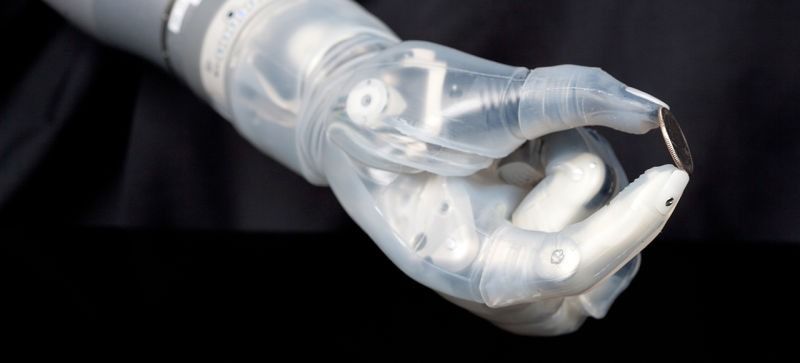One of gene therapy’s major challenges is getting a gene sequence into a cell without damaging it. Traditional methods are often inefficient and unreliable, but this nano-device from Brigham Young University may offer a solution.


One of gene therapy’s major challenges is getting a gene sequence into a cell without damaging it. Traditional methods are often inefficient and unreliable, but this nano-device from Brigham Young University may offer a solution.

A 28 year old man who has been paralysed has been given a new sense of touch following a new breakthrough that saw electrodes places directly into the man’s brain.
The research and clinical trial has been carried out by DARPA, the US Military’s research agency. Essentially, the man (who has not been named) is now able to control his new hand and feel people touching it because of two sets of electrodes: one array on the motor cortex, the part of the brain which directs body movement, and one on the sensory cortex, which is the part of the brain which feels touch.

DARPA promised prosthetic limbs that produce realistic sensations, and it’s making good on its word. The agency’s researchers have successfully tested an artificial hand that gave a man a “near-natural” level of touch. The patient could tell when scientists were pressing against specific fingers, even when they tried to ‘trick’ the man by touching two digits at once. The key was to augment the thought-controlled hand with a set of pressure-sensitive torque motors wired directly to the brain — any time the hand touched something, it sent electrical signals that felt much like flesh-and-bone contact.
There’s still a lot of work left to go before this hardware is truly realistic, of course. The sensors don’t cover the entire hand, and they don’t account for temperature or other factors you’ll likely worry about when grabbing objects. Still, this should represent a big step forward. Provided the technology takes off, both amputees and paralysis victims could regain some of the tactility they once had.

Why is cancer so deadly? It spreads and consumes in a process called metastasis. If it stayed put we’d have an easier fight on our hands. Researchers hope this sponge-like implant could offer an intriguing solution, sucking up circulating cancer cells and warning you of their presence early on.
9 out of 10 cancer deaths are caused by spreading to other organs
Time is often cited as ‘our most precious resource’. Beating cancer is no exception to this; if we caught every cancer early success rates would be vastly improved. Curing cancer therefore requires more than simply destroying these cells. It also means improving diagnosis.

Researchers at the University of Massachusetts Medical School are the first to show that it’s possible to reverse the behavior of an animal by flipping a switch in neuronal communication. The research, published in PLOS Biology, provides a new approach for studying the neural circuits that govern behavior and has important implications for how scientists think about neural connectomes.
New technologies have fueled the quest to map all the neural connections in the brain to understand how these networks processes information and control behavior. The human brain consists of 1011 neurons that make 1015 connections. The total length of neuronal processes in the human brain is approximately 4 million miles long, similar in length to the total number of roads in the U.S. Along these networks neurons communicate with each other through excitatory and inhibitory synapses that turn neurons on or off.
The neuronal roadmap, or connectome, however, doesn’t include information about the activity of neurons or the signals they transmit. How stable are these neural circuits in the brain? Does their wiring constrain the flow of information or the behaviors they control? The complexity of the human brain makes it almost impossible to address these questions.

This particular giant virus won’t kill you, but climate change means that something deadly could one day emerge.

Cancer claimed Kim Suozzi at age 23, but she chose to have her brain preserved with the dream that neuroscience might one day revive her mind.
By AMY HARMON SEPT. 12, 2015.

https://youtube.com/watch?v=bwz9SPMDO2k
The US government said today (Sept. 11) that it’s successfully made a Luke Skywalker-like prosthetic arm that allows the wearer to actually feel things.
At a conference in July, the US Defense Advanced Research Projects Agency (DARPA) presented the achievements it’d had to date in building a robot arm that can be controlled by a human brain. A little over two months later, the agency has announced at another conference that it’s managed to update the technology to give the wearer the feeling of actually being able to sense things with the arm.
The robotic arm is connected by wires that link up to the wearer’s motor cortex—the part of the brain that controls muscle movement—and sensory cortex, which identifies tactile sensations when you touch things. The wires from the motor cortex allow the wearer to control the motion of the robot arm, and pressure sensors in the arm that connect back into the sensory cortex give the wearer the sensation that they are touching something.

So, you think you’ve seen it all? You haven’t seen anything yet. By the year 2030, advancements will excel anything we’ve seen before concerning human intelligence. In fact, predictions offer glimpses of something truly amazing – the development of a human hybrid, a mind that thinks in artificial intelligence.
Ray Kurzweil, director of engineering at Google, spoke openly about this idea at the Exponential Finance Conference in New York. He predicts that humans will have hybrid brains able to connect to the cloud, just as with computers. In this cloud, there will be thousands of computers which will update human intelligence. The larger the cloud, the more complicated the thinking. This will all be connected using DNA strands called Nanobots. Sounds like a Sci-Fi movie, doesn’t it?
Kurzweil says:

Synthetics startup Ras Labs is working with the International Space Station to test “smart materials” that contract like living tissue. These “electroactive” materials can expand, contract and conform to our limbs just like human muscles when a current moves through them – and they could be used to make robots move and feel more human to the touch.
Ras Labs co-founder Lenore Rasmussen accidentally stumbled upon the synthetic muscle material years ago while mixing chemicals in the lab at Virginia Tech. The experiment turned out to be with the wrong amount of ingredients, but it produced a blob of wobbly jelly that Rasmussen noticed contracted and expanded like muscles when she applied an electrical current.
It would be years later when Rasmussen’s cousin nearly lost his foot in a farming accident that she would start to employ that discovery to robotic limbs and space travel. The co-founder thought her cousin might lose his foot and started researching prosthetics.